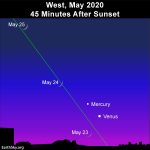
At evening dusk – May 23, 24 and 25, 2020 – find an unobstructed horizon in the direction of sunset, and watch for the young moon, plus the planets Mercury and Venus, to pop out in the deepening twilight. From many places worldwide, it’ll be tough to spot the whisker-thin lunar crescent beneath Venus and Mercury on May 23, because the moon will be out only briefly after sunset. It’ll be a lovely, fragile crescent that’ll follow the sun beneath the horizon before true darkness falls. Then on May 24 and 25, the moon will be easy. And, on all of these evenings, the planets near the moon will be breathtaking, with Venus piercing the very bright twilight and Mercury slightly higher up.
The Mercury-Venus conjunction took place on May 22 at around 7 UTC. That is when Mercury swept 0.9 degrees S. of Venus on our sky’s dome, and it’s why Mercury is now higher in the sky than Venus.
Click here to find out when the moon will set in your sky, remembering to check the moonrise/moonset box.
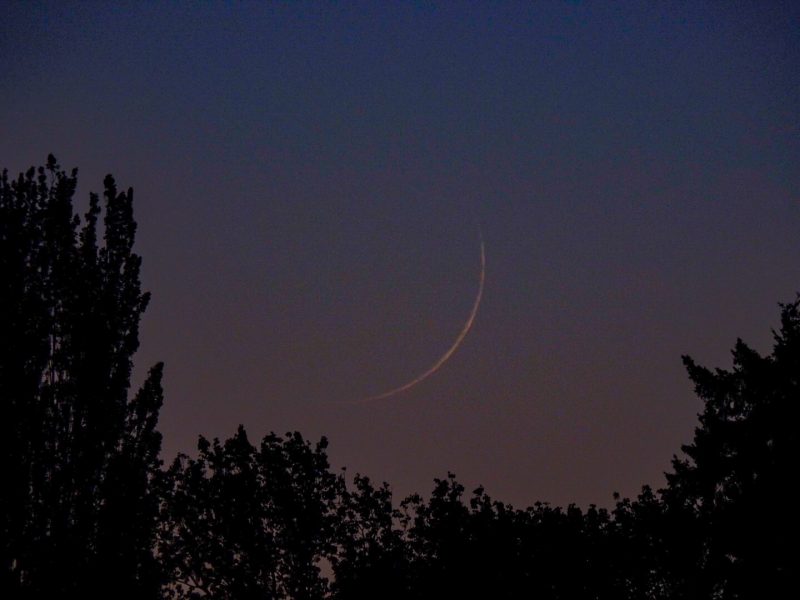
View larger at EarthSky Community Photos. Congratulations to Dustin Guy of Seattle, Washington, U.S., who caught last year’s May young moon after sunset May 5, 2019. Thank you, Dustin!
On May 23, you may well have an easier time spotting Venus than the young moon. After all, dazzling Venus ranks as the 3rd-brightest celestial object, after the sun and moon. But Venus looms higher up in the sky at sunset May 23, while the young moon is more submerged in the sunset glare. People with good vision (or binoculars) might see Venus as little as 10 to 20 minutes after sundown. Once you catch Venus, seek for a faint glimmer of lunar crescent in between Venus and the horizon at dusk May 23. While you’re at it, seek for Mercury above Venus with the eye alone or binoculars. Good luck!
Live in the United States or Canada? Find out when Mercury and Venus set in your sky via Old Farmer’s Almanac. Find out the sunrise/sunset times first and then scroll down to Rise and set times for the moon and planets.
Live elsewhere worldwide? Find out the setting times for Mercury and Venus via TimeandDate Planets.
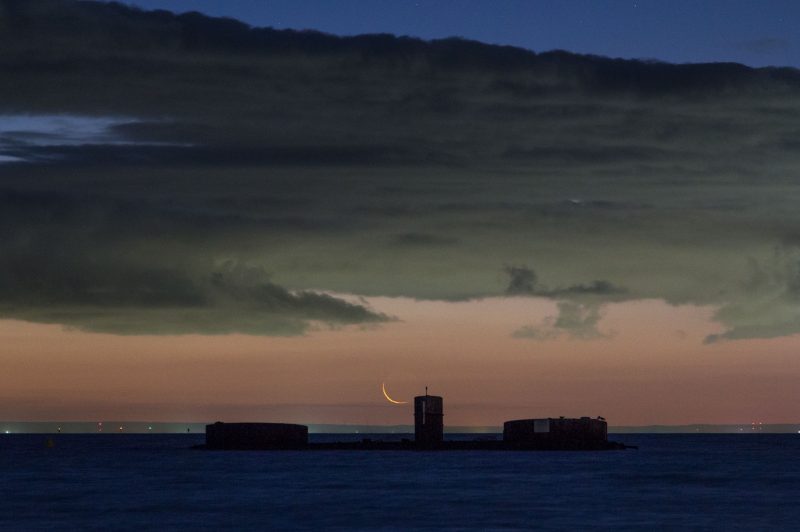
View larger at EarthSky Community Photos. Last year, Mark Sansom of Melbourne, Australia, caught the young crescent in the west after sunset on May 6, 2019. Note that the crescent tilts in a different direction than in the above photo from the Northern Hemisphere. Thank you Mark!
Given clear skies, the young lunar crescent will be much easier to catch after the sun goes down on May 24 and 25. Day by day, a wider lunar crescent appears higher in the sky at sunset, and the moon stays out longer after dark. You’re also more likely to view the soft glow of earthshine on the dark – or nighttime – side of the moon. Earthshine is twice-reflected sunlight, with sunlight being reflected from Earth to the moon, and then from the moon back to Earth.
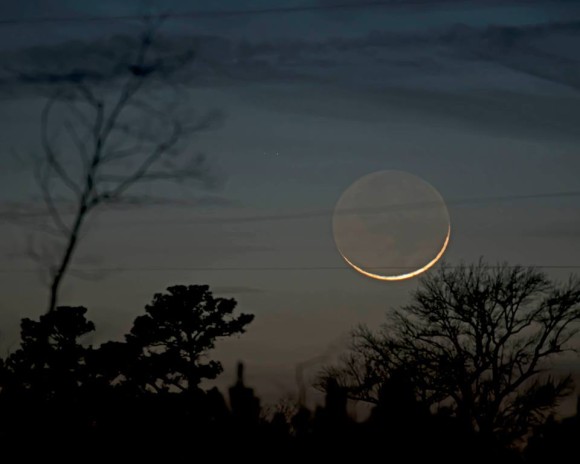
Ken Christison caught a very young moon, with its dark side all aglow in earthshine, on March 31, 2014, the day after a new moon.
Unlike the moon, which is climbing away from the setting sun, Venus is sinking closer to the sun day by day. These next several days will present Venus’ farewell appearance in the evening sky, before this world finally succumbs to the sun’s glare by the month’s end. In other words, May 2020 showcases the year’s final pairing of the crescent moon and Venus in the evening sky.
Mercury, on the other hand, is still edging away from the sun, to reach its greatest elongation (maximum angular separation from the sun) on June 4, 2020. So Mercury’s presence in the evening sky could last for another week or two. However, this world is dimming day by day, so we advise you not to dally. Catch Mercury while it’s still bright and beautiful, and you still have the young moon there to guide you. And don’t forget binoculars, if you have them.
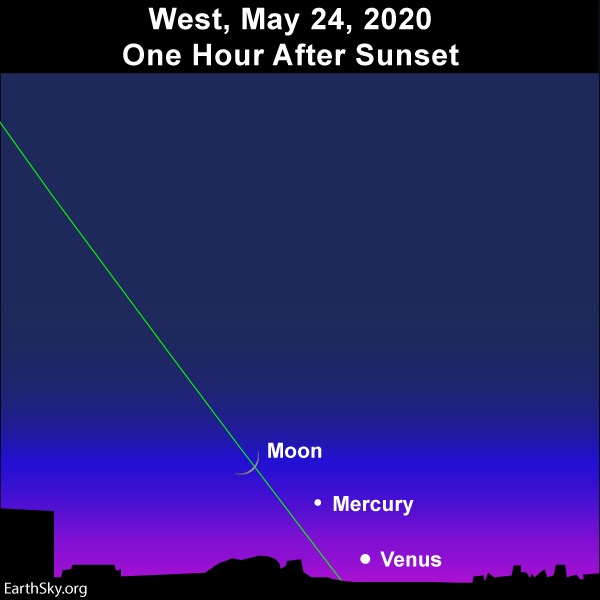
We anticipate May 24 being the best date for observing the celestial threesome. Although this chart is especially made for mid-northern North American latitudes, the young moon will be close to these two planets on this date (May 24) everywhere worldwide. On May 24, from the world’s Eastern Hemisphere – Europe, Africa, Asia, Australia and New Zealand – you’ll actually see the moon closer to Mercury and Venus than we will in North America.
May 24 might present the optimal date for viewing this gorgeous celestial threesome as dusk gives way to darknnes. As seen from around the world, the young moon, Venus and Mercury will be fairly close together on the sky’s dome, enabling you to hop from the young moon to Mercury and Venus with minimal effort. (See the sky chart above.) Once again, we encourage you to bring along binoculars.
Bottom line: Shortly after sunset on May 23, 24 and 25, 2020, watch the great drama in your western twilight sky, as the young moon meets up with the two inferior planets, Mercury and Venus.
from EarthSky https://ift.tt/2ZwQXNE

At evening dusk – May 23, 24 and 25, 2020 – find an unobstructed horizon in the direction of sunset, and watch for the young moon, plus the planets Mercury and Venus, to pop out in the deepening twilight. From many places worldwide, it’ll be tough to spot the whisker-thin lunar crescent beneath Venus and Mercury on May 23, because the moon will be out only briefly after sunset. It’ll be a lovely, fragile crescent that’ll follow the sun beneath the horizon before true darkness falls. Then on May 24 and 25, the moon will be easy. And, on all of these evenings, the planets near the moon will be breathtaking, with Venus piercing the very bright twilight and Mercury slightly higher up.
The Mercury-Venus conjunction took place on May 22 at around 7 UTC. That is when Mercury swept 0.9 degrees S. of Venus on our sky’s dome, and it’s why Mercury is now higher in the sky than Venus.
Click here to find out when the moon will set in your sky, remembering to check the moonrise/moonset box.

View larger at EarthSky Community Photos. Congratulations to Dustin Guy of Seattle, Washington, U.S., who caught last year’s May young moon after sunset May 5, 2019. Thank you, Dustin!
On May 23, you may well have an easier time spotting Venus than the young moon. After all, dazzling Venus ranks as the 3rd-brightest celestial object, after the sun and moon. But Venus looms higher up in the sky at sunset May 23, while the young moon is more submerged in the sunset glare. People with good vision (or binoculars) might see Venus as little as 10 to 20 minutes after sundown. Once you catch Venus, seek for a faint glimmer of lunar crescent in between Venus and the horizon at dusk May 23. While you’re at it, seek for Mercury above Venus with the eye alone or binoculars. Good luck!
Live in the United States or Canada? Find out when Mercury and Venus set in your sky via Old Farmer’s Almanac. Find out the sunrise/sunset times first and then scroll down to Rise and set times for the moon and planets.
Live elsewhere worldwide? Find out the setting times for Mercury and Venus via TimeandDate Planets.

View larger at EarthSky Community Photos. Last year, Mark Sansom of Melbourne, Australia, caught the young crescent in the west after sunset on May 6, 2019. Note that the crescent tilts in a different direction than in the above photo from the Northern Hemisphere. Thank you Mark!
Given clear skies, the young lunar crescent will be much easier to catch after the sun goes down on May 24 and 25. Day by day, a wider lunar crescent appears higher in the sky at sunset, and the moon stays out longer after dark. You’re also more likely to view the soft glow of earthshine on the dark – or nighttime – side of the moon. Earthshine is twice-reflected sunlight, with sunlight being reflected from Earth to the moon, and then from the moon back to Earth.

Ken Christison caught a very young moon, with its dark side all aglow in earthshine, on March 31, 2014, the day after a new moon.
Unlike the moon, which is climbing away from the setting sun, Venus is sinking closer to the sun day by day. These next several days will present Venus’ farewell appearance in the evening sky, before this world finally succumbs to the sun’s glare by the month’s end. In other words, May 2020 showcases the year’s final pairing of the crescent moon and Venus in the evening sky.
Mercury, on the other hand, is still edging away from the sun, to reach its greatest elongation (maximum angular separation from the sun) on June 4, 2020. So Mercury’s presence in the evening sky could last for another week or two. However, this world is dimming day by day, so we advise you not to dally. Catch Mercury while it’s still bright and beautiful, and you still have the young moon there to guide you. And don’t forget binoculars, if you have them.

We anticipate May 24 being the best date for observing the celestial threesome. Although this chart is especially made for mid-northern North American latitudes, the young moon will be close to these two planets on this date (May 24) everywhere worldwide. On May 24, from the world’s Eastern Hemisphere – Europe, Africa, Asia, Australia and New Zealand – you’ll actually see the moon closer to Mercury and Venus than we will in North America.
May 24 might present the optimal date for viewing this gorgeous celestial threesome as dusk gives way to darknnes. As seen from around the world, the young moon, Venus and Mercury will be fairly close together on the sky’s dome, enabling you to hop from the young moon to Mercury and Venus with minimal effort. (See the sky chart above.) Once again, we encourage you to bring along binoculars.
Bottom line: Shortly after sunset on May 23, 24 and 25, 2020, watch the great drama in your western twilight sky, as the young moon meets up with the two inferior planets, Mercury and Venus.
from EarthSky https://ift.tt/2ZwQXNE

Aucun commentaire:
Enregistrer un commentaire